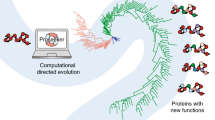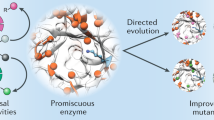Abstract
Enzymes are exceptional catalysts that facilitate a wide variety of reactions under mild conditions, achieving high rate-enhancements with excellent chemo-, regio- and stereoselectivities. There is considerable interest in developing new enzymes for the synthesis of chemicals and pharmaceuticals1,2,3 and as tools for molecular biology. Methods have been developed for modifying and improving existing enzymes through screening, selection and directed evolution4,5. However, the design and evolution of truly novel enzymes has relied on extensive knowledge of the mechanism of the reaction6,7,8,9,10. Here we show that genuinely new enzymatic activities can be created de novo without the need for prior mechanistic information by selection from a naive protein library of very high diversity, with product formation as the sole selection criterion. We used messenger RNA display, in which proteins are covalently linked to their encoding mRNA11, to select for functional proteins from an in vitro translated protein library of >1012independent sequences without the constraints imposed by any in vivo step. This technique has been used to evolve new peptides and proteins that can bind a specific ligand12,13,14,15,16,17,18, from both random-sequence libraries12,14,15,16 and libraries based on a known protein fold17,18. We now describe the isolation of novel RNA ligases from a library that is based on a zinc finger scaffold18,19, followed by in vitro directed evolution to further optimize these enzymes. The resulting ligases exhibit multiple turnover with rate enhancements of more than two-million-fold.
This is a preview of subscription content, access via your institution
Access options
Subscribe to this journal
Receive 51 print issues and online access
$199.00 per year
only $3.90 per issue
Buy this article
- Purchase on Springer Link
- Instant access to full article PDF
Prices may be subject to local taxes which are calculated during checkout




Similar content being viewed by others
Change history
18 October 2007
In the PDF and print versions of this manuscript, the vertical arrow indicating the ligation junction was incorrectly placed two letters to the left during production. This was corrected on this HTML version on 18 October 2007.
References
Schmid, A. et al. Industrial biocatalysis today and tomorrow. Nature 409, 258–268 (2001)
Cherry, J. R. & Fidantsef, A. L. Directed evolution of industrial enzymes: an update. Curr. Opin. Biotechnol. 14, 438–443 (2003)
Panke, S., Held, M. & Wubbolts, M. Trends and innovations in industrial biocatalysis for the production of fine chemicals. Curr. Opin. Biotechnol. 15, 272–279 (2004)
Bloom, J. D. et al. Evolving strategies for enzyme engineering. Curr. Opin. Struct. Biol. 15, 447–452 (2005)
Aharoni, A., Griffiths, A. D. & Tawfik, D. S. High-throughput screens and selections of enzyme-encoding genes. Curr. Opin. Chem. Biol. 9, 210–216 (2005)
Bolon, D. N. & Mayo, S. L. Enzyme-like proteins by computational design. Proc. Natl Acad. Sci. USA 98, 14274–14279 (2001)
Dwyer, M. A., Looger, L. L. & Hellinga, H. W. Computational design of a biologically active enzyme. Science 304, 1967–1971 (2004)
Park, H. S. et al. Design and evolution of new catalytic activity with an existing protein scaffold. Science 311, 535–538 (2006)
Cesaro-Tadic, S. et al. Turnover-based in vitro selection and evolution of biocatalysts from a fully synthetic antibody library. Nature Biotechnol. 21, 679–685 (2003)
Xu, Y., Yamamoto, N. & Janda, K. D. Catalytic antibodies: hapten design strategies and screening methods. Bioorg. Med. Chem. 12, 5247–5268 (2004)
Roberts, R. W. & Szostak, J. W. RNA–peptide fusions for the in vitro selection of peptides and proteins. Proc. Natl Acad. Sci. USA 94, 12297–12302 (1997)
Keefe, A. D. & Szostak, J. W. Functional proteins from a random-sequence library. Nature 410, 715–718 (2001)
Wilson, D. S., Keefe, A. D. & Szostak, J. W. The use of mRNA display to select high-affinity protein-binding peptides. Proc. Natl Acad. Sci. USA 98, 3750–3755 (2001)
Baggio, R. et al. Identification of epitope-like consensus motifs using mRNA display. J. Mol. Recognit. 15, 126–134 (2002)
Cujec, T. P., Medeiros, P. F., Hammond, P., Rise, C. & Kreider, B. L. Selection of v-abl tyrosine kinase substrate sequences from randomized peptide and cellular proteomic libraries using mRNA display. Chem. Biol. 9, 253–264 (2002)
Raffler, N. A., Schneider-Mergener, J. & Famulok, M. A novel class of small functional peptides that bind and inhibit human alpha-thrombin isolated by mRNA display. Chem. Biol. 10, 69–79 (2003)
Xu, L. H. et al. Directed evolution of high-affinity antibody mimics using mRNA display. Chem. Biol. 9, 933–942 (2002)
Cho, G. S. & Szostak, J. W. Directed evolution of ATP binding proteins from a zinc finger domain by using mRNA display. Chem. Biol. 13, 139–147 (2006)
Holmbeck, S. M. A. et al. High-resolution solution structure of the retinoid X receptor DNA-binding domain. J. Mol. Biol. 281, 271–284 (1998)
Cadwell, R. C. & Joyce, G. F. Randomization of genes by PCR mutagenesis. PCR Methods Appl. 2, 28–33 (1992)
Wilson, D. S. & Keefe, A. D. in Current Protocols in Molecular Biology (eds Ausubel, F. et al.) Suppl. 51, unit 8.3 (Wiley, New York, 2000)
Slootstra, J. W., Kuperus, D., Pluckthun, A. & Meloen, R. H. Identification of new tag sequences with differential and selective recognition properties for the anti-FLAG monoclonal antibodies M1, M2 and M5. Mol. Divers. 2, 156–164 (1997)
Rohatgi, R., Bartel, D. P. & Szostak, J. W. Kinetic and mechanistic analysis of nonenzymatic, template-directed oligoribonucleotide ligation. J. Am. Chem. Soc. 118, 3332–3339 (1996)
Griffiths, A. D. & Tawfik, D. S. Man-made enzymes — from design to in vitro compartmentalisation. Curr. Opin. Biotechnol. 11, 338–353 (2000)
Bryant, F. R. & Benkovic, S. J. On the mechanism of T4 RNA ligase. J. Am. Chem. Soc. 103, 696–697 (1981)
Bonner, G., Lafer, E. M. & Sousa, R. Characterization of a set of T7 RNA-polymerase active site mutants. J. Biol. Chem. 269, 25120–25128 (1994)
Bartel, D. P. & Szostak, J. W. Isolation of new ribozymes from a large pool of random sequences. Science 261, 1411–1418 (1993)
Purtha, W. E., Coppins, R. L., Smalley, M. K. & Silverman, S. K. General deoxyribozyme-catalyzed synthesis of native 3′–5′ RNA linkages. J. Am. Chem. Soc. 127, 13124–13125 (2005)
Ekland, E. H., Szostak, J. W. & Bartel, D. P. Structurally complex and highly-active RNA ligases derived from random RNA sequences. Science 269, 364–370 (1995)
Volckaert, G. & Fiers, W. Micro thin-layer techniques for rapid sequence-analysis of P-32-Labeled RNA - double digestion and pancreatic ribonuclease analyses. Anal. Biochem. 83, 228–239 (1977)
Moore, M. J. & Sharp, P. A. Site-specific modification of pre-messenger-RNA — the 2'-hydroxyl groups at the splice sites. Science 256, 992–997 (1992)
Kurz, M., Gu, K. & Lohse, P. A. Psoralen photo-crosslinked mRNA-puromycin conjugates: a novel template for the rapid and facile preparation of mRNA–protein fusions. Nucleic Acids Res. 28, e83 (2000)
Cho, G., Keefe, A. D., Liu, R. H., Wilson, D. S. & Szostak, J. W. Constructing high complexity synthetic libraries of long ORFs using in vitro selection. J. Mol. Biol. 297, 309–319 (2000)
Liu, R. H., Barrick, J. E., Szostak, J. W. & Roberts, R. W. Optimized synthesis of RNA–protein fusions for in vitro protein selection. Methods Enzymol. 318, 268–293 (2000)
McCafferty, D. G., Lessard, I. A. D. & Walsh, C. T. Mutational analysis of potential zinc-binding residues in the active site of the enterococcal D-Ala-D-Ala dipeptidase VanX. Biochemistry 36, 10498–10505 (1997)
Hall, T. A. BioEdit: a user-friendly biological sequence alignment editor and analysis program for Windows 95/98/NT. Nucl. Acids Symp. Ser. 41, 95–98 (1999)
Corpet, F. Multiple sequence alignment with hierarchical-clustering. Nucleic Acids Res. 16, 10881–10890 (1988)
Acknowledgements
We thank G. S. Cho for providing the RXR library before its publication along with valuable advice; A. D. Keefe for critical input during the initiation of this project; C. Mueller-Vahl for help with protein expression and purification; G.-P. Zhou and J. J. Chou for NMR measurements; A. D. Keefe, G. S. Cho, G. F. Short, R. Larralde, J. M. Carothers, J. K. Ichida, F. P. Seebeck, S. S. Mansy, C. Del Bianco, D. A. Treco, D. S. Wilson, A. J. Bell, A. Luptak, R. Bruckner and Z. Sachs for helpful discussions. This work was supported by a grant from the NASA Astrobiology Institute. B.S. was supported in part by the Emmy Noether-Programm of the Deutsche Forschungsgemeinschaft. J.W.S. is an Investigator of the Howard Hughes Medical Institute.
Author Contributions All experiments were performed by B.S. Both authors designed the experiments, discussed the results and wrote the paper.
Author information
Authors and Affiliations
Corresponding author
Ethics declarations
Competing interests
The DNA sequences encoding the ligase enzymes 1-7 have been deposited in GenBank under the accession numbers EU019543 to EU019549, respectively. Reprints and permissions information is available at www.nature.com/reprints. The authors declare no competing financial interests.
Supplementary information
Supplementary Figures
This file contains Supplementary Figures 1-2 with Legends and sequences of oligonucleotides, DNA library, selected clones. (PDF 173 kb)
Rights and permissions
About this article
Cite this article
Seelig, B., Szostak, J. Selection and evolution of enzymes from a partially randomized non-catalytic scaffold. Nature 448, 828–831 (2007). https://doi.org/10.1038/nature06032
Received:
Accepted:
Published:
Issue Date:
DOI: https://doi.org/10.1038/nature06032
This article is cited by
-
Genetically engineered proteins with two active sites for enhanced biocatalysis and synergistic chemo- and biocatalysis
Nature Catalysis (2019)
-
Comparing proteins and nucleic acids for next-generation biomolecular engineering
Nature Reviews Chemistry (2018)
-
A de novo enzyme catalyzes a life-sustaining reaction in Escherichia coli
Nature Chemical Biology (2018)
-
Compartmentalized partnered replication for the directed evolution of genetic parts and circuits
Nature Protocols (2017)
-
Classification of the treble clef zinc finger: noteworthy lessons for structure and function evolution
Scientific Reports (2016)
Comments
By submitting a comment you agree to abide by our Terms and Community Guidelines. If you find something abusive or that does not comply with our terms or guidelines please flag it as inappropriate.



